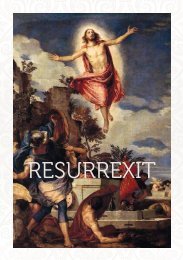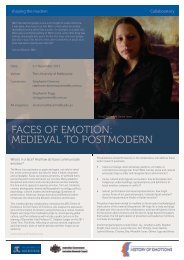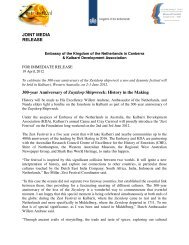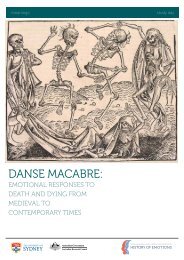Download our K-12 education pack - ARC Centre of Excellence for ...
Download our K-12 education pack - ARC Centre of Excellence for ...
Download our K-12 education pack - ARC Centre of Excellence for ...
You also want an ePaper? Increase the reach of your titles
YUMPU automatically turns print PDFs into web optimized ePapers that Google loves.
stories <strong>for</strong> teachers & students 2013<br />
Abundance<br />
This is an example <strong>of</strong> a fruytje (little fruit) painting, in which the<br />
beauty <strong>of</strong> delectable ripe fruit is laid out <strong>for</strong> the viewer’s<br />
enjoyment. It celebrated the joy <strong>of</strong> abundance in a style <strong>of</strong> still<br />
life known as pronkstilleven; that is, still life paintings which<br />
were intended to be ostentatious and showy. However, some<br />
artists pushed ripeness to its limits, showing fruit ready to burst<br />
open or just on the edge <strong>of</strong> decay.<br />
This hint <strong>of</strong> rot was a subtle reminder <strong>of</strong> the transcience <strong>of</strong> life.<br />
Sensual pleasure and even human beauty could not be enjoyed<br />
without the moral reminder <strong>of</strong> the decay to follow. This is hinted<br />
at here through the inclusion <strong>of</strong> that most transitory <strong>of</strong> creatures,<br />
the butterfly. The pomegranate could be used at the time both to<br />
symbolise lust and temptation, as well as warnings against it,<br />
depending on the objects that accompanied it.<br />
For contemporaries, many <strong>of</strong> the objects depicted in such still<br />
lifes held a second set <strong>of</strong> meanings, reflecting well known<br />
religious symbolism. The grapes were a symbol <strong>of</strong> the Eucharist,<br />
peaches <strong>of</strong> salvation, the butterfly represented resurrection, as<br />
did the carnation, a symbol <strong>of</strong> eternal life.<br />
Supporting Res<strong>our</strong>ces<br />
Dutch Lives in the World<br />
stories by winthrop pr<strong>of</strong>essor susan broomhall<br />
Those artists who specialised in still lifes tended to work <strong>for</strong> the<br />
commercial market, rather than <strong>for</strong> patrons. Dutch society was<br />
highly visually literate; images abounded throughout their<br />
culture. It has been argued that the Dutch understood and<br />
represented themselves through art, in the same way that<br />
Elizabethan England did through theatre. As such, artists chose<br />
objects, and combinations <strong>of</strong> them, that were readily meaningful<br />
as well as aesthetically pleasurable <strong>for</strong> their potential buyers.<br />
The pleasure that these paintings gave is attested by the fact that<br />
Huysum was among the most popular and well-paid artists <strong>of</strong><br />
his day, with an international reputation and clientele. Perhaps<br />
surprisingly, he led a reclusive life and only ever agreed to take<br />
on one pupil, Margaretha Haverman.<br />
Image/ Jan van Huysum, Still life with fruit. On a stone plinth, in the middle, a bunch<br />
<strong>of</strong> white grapes, peaches, plums, a cut pomegranate and a half melon, with<br />
butterflies and other insects, 1700-1749. © Rijksmuseum.<br />
She was not alone in wanting artistic training. A number <strong>of</strong><br />
talented Dutch female painters enjoyed success during the<br />
Golden Age, such as Rachael Ruysch, Judith Leyster, Maria van<br />
Oosterwyck, Maria Sibylla Merian, Gesina ter Boch and Anna<br />
Maria van Schurman, working mainly in areas <strong>of</strong> artistic<br />
composition considered appropriate to their sex such as still life,<br />
botanical subjects, and family portraits. Much <strong>of</strong> their output is<br />
only now being rediscovered in museums, archives and in private<br />
collections and other works have been reattributed to them as<br />
we learn more about their production.<br />
FAR FROM HOME: ADVENTURES, TREKS, EXILES & MIGRATION<br />
55












